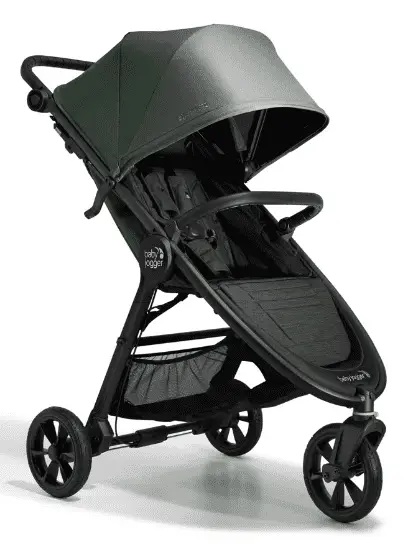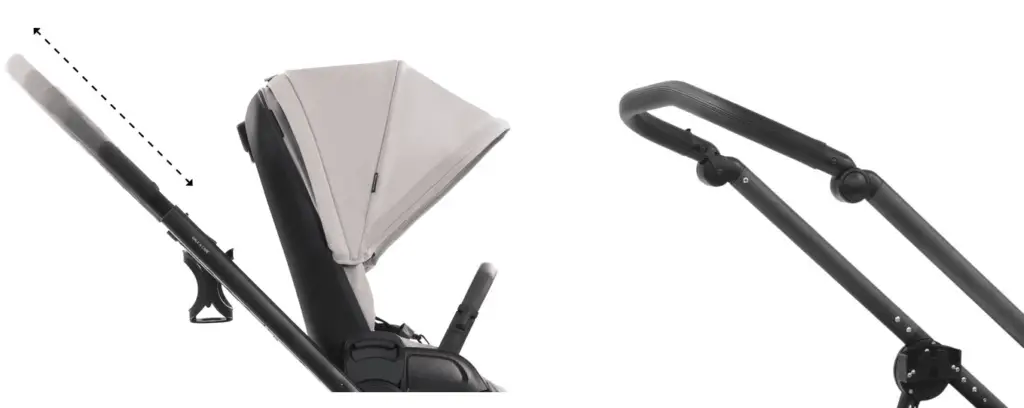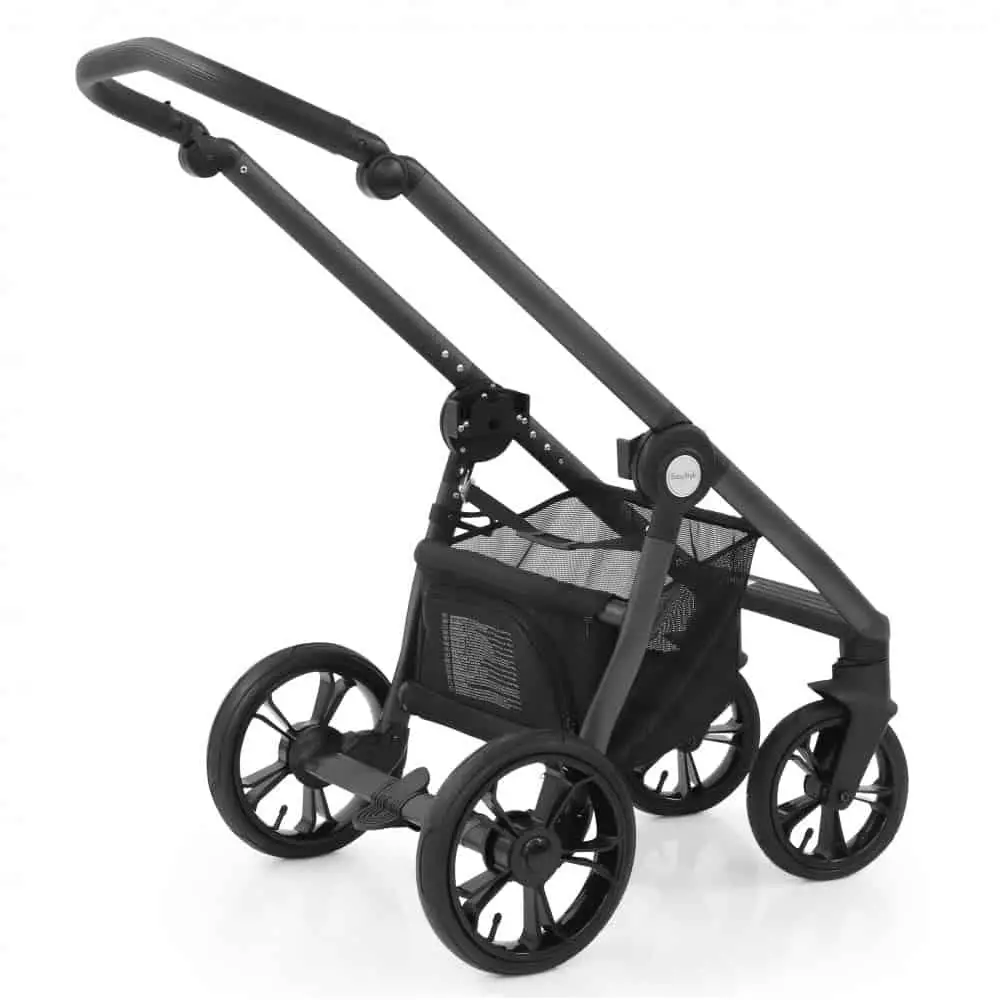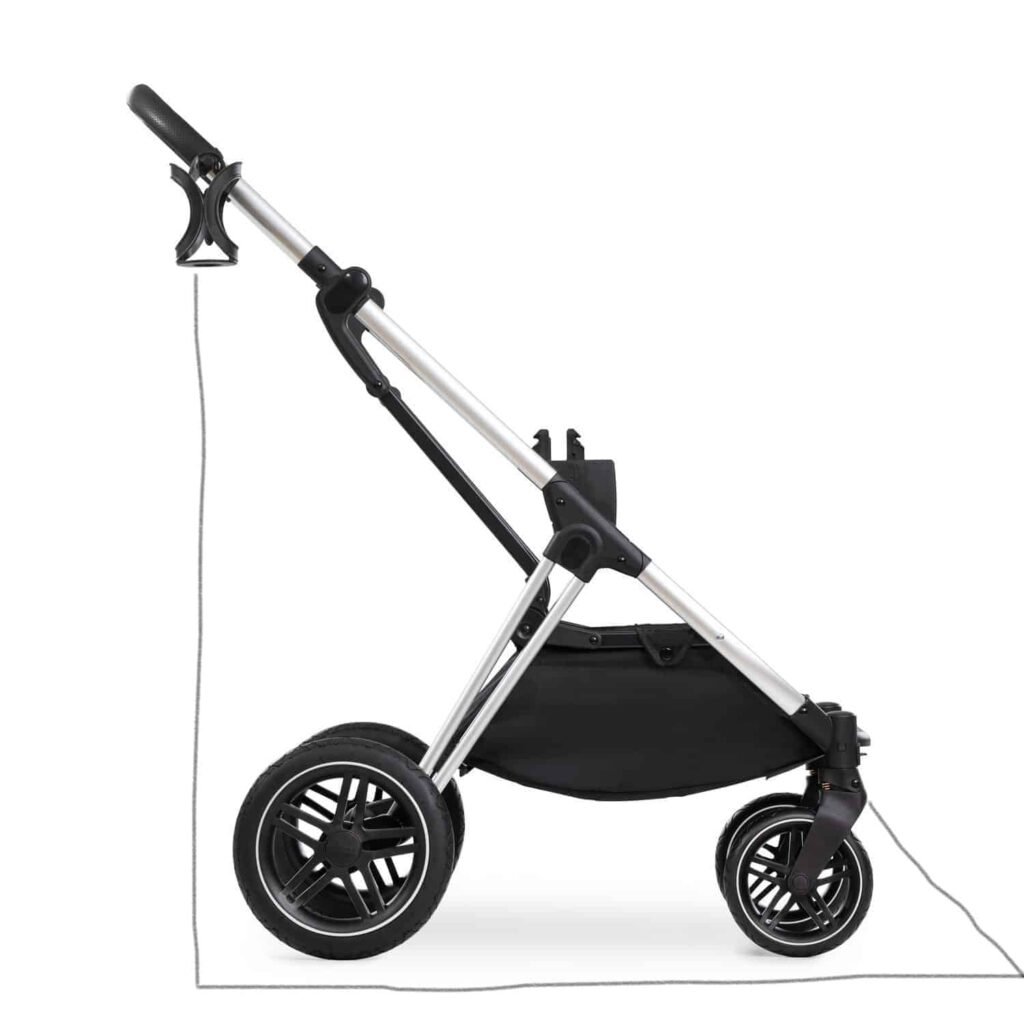The 5 tips for buying a baby stroller we will look into in this article, are the most fundamental things to look for when buying a stroller. If you’re looking for information that can help you navigate through the chaos of too many options, read on.
1. The Chassis
It would be apt to start with the chassis (frame) and how it is put together, as it is what holds all the different parts of the stroller together. It is kind of the skeleton on which the stroller is built, where the various bars, hubs and components are fit and connected to each other.
The chassis is the place where you should have a close look, and find if the connection points are well reinforced instead of just ordinary riveting. This is crucial, because most if not all chassis of strollers out there only have a riveting, which should be taken as an indicator of cheap design and craftsmanship.
What you need are good, thick and enclosed plastic joints like those found in Baby Jogger City Mini GT2, or crossbars that are welded well, or metal bars that are curved and incorporate horizontal stability into a single piece.

Also, all the other elements of the stroller should be slotted into each other with a rivet or screw, such that it is running through the entire connection point.
With strollers that do not have large enclosing elements that helps distribute pressure away from the rivets, there’s a tendency for the holes in the bars to widen, and for the rivets themselves to weaken.
For the stroller as a whole, this would mean looser chassis and potential breaking points in more than just a couple of places.
2. Handle
The handle needs to be built strong enough, so that it can tackle the pushing, steering and tipping when the stroller is fully loaded. You also want that extra strength for the handle, preferably with the capability of supporting slightly more than the officially stated weight capacity.
Of all the many components that together make up a stroller, the handle is the one which will take on the most stress. The two key aspects at play when it comes to the handle, are: The strength of the arms, and the efficiency of the folding mechanism found in strollers from Baby Jogger.
The Most Problem Area
Having said, the most common problem with stroller handle bar that is poorly designed, is in the handle’s height extension mechanism.
There are two main types of stroller handles:

Telescopic: Generally speaking, telescopic mechanisms (left of picture above) are better these days, as they are a rigid structure and can stand up to a way lot more pressure compared to the hinged.
Hinged: In relation to the telescopic ones, hinged mechanisms are relatively old-school in terms of design and are likely to be prone to looseness, to start with. Eventually, they could end up cracking or even breaking (with few exceptions).
It is critical that the handle is built sturdy, as it has deal with the distribution of weight across the stroller as a whole.
But not all strollers with a hinged mechanism have a problem. For instance, a 3-wheel strollers from Baby Jogger can get away with a hinged mechanism, and in fact do better than most telescopic ones, because it is designed well and built in a very sturdy.
One of the noteworthy aspects of Baby Jogger’s design is that it’s center of gravity is more back-loaded, therefore requiring less force to steer it forward.
3. Front Wheel(s)
The size of the front wheel is one of the key determining factors for how terrain-capable a particular model of stroller will be. Needless to mention, other factors like suspension and general sturdiness are important as well.
2 Things About The Front Wheel(s)

First important thing about the front wheels, is that they are the first part of the stroller to encounter any of the actual impediments, like roots, stones, rocks, pebbles and so on. If they’re not big enough to comfortably roll over such obstacles to start with, then it doesn’t really matter how fancy the design and technology of the rear-wheels’ suspensions are!
Second, is how well are the wheels fixed within a given model’s front frame housings. Because, as with the handle, this is an area that needs good reinforcement.
Ideally, it shouldn’t move at all. If it moves a little, you may still go with your prospective model, provided the manufacturer has built quality shock absorption features into the housings. You can check this (takes only a few seconds) by removing the front wheel and looking both at the top of the fork and the underside of the housing.
There are a wide variety of shock absorbing solutions that may be utilized here, the best being spring-loaded pads. But it is very likely you may come across either ‘O’ rings or plastic tags, both of which are definitely better than nothing. They can both stave off wobble issues for about 2 to 3 years, depending on the terrain they are used on.
Before moving on …
You have to keep in mind that the last 2 tips for buying a baby stroller are a more generic in nature, meaning it does not specifically deal with any part of a stroller. Rather, they are about having the right mind-set or perspective about what to look for when buying a stroller.
With that having said, let’s continue.
4. Simplicity & Sturdiness
It will serve you well if you value simplicity and sturdiness of a stroller over its fancy mechanical features. Like many things in life, simplicity has value, and value very often comes from a place of simplicity.

The interesting thing about mechanics is that more there are mechanical components in a system, more is the likelihood of complexities. From the longevity standpoint therefore, fewer the number of components, the better.
Fewer components mean fewer functions, which in turn means fewer connection points that could get weakened, and fewer internal moving parts, therefore minimising the likelihood of problems down the line.
For example, when it comes to the seat, a seat built on a strong and sturdy frame with only a central point for adjusting its position will have less potential for problems, than in those models with adjustable backs and foot rests.
5. Performance Over Style
Remember: Perspective is everything!
It is important, therefore, that you look at your stroller as a tool.
Nothing more. Nothing less.
And for a few years it’s going to be quite an important tool you will need. This means if-or-when it fails to perform the way you need it to, say when you’re out there at the grocery store and the basket is fully loaded, but you’re coming back with a somewhat less-than-satisfied baby, then it’s definitely going to be a big deal.
This is just one of the many reasons why for most parents, it will be absolutely worthwhile to pick a stroller with an overall design that is significantly aimed at performance and little on style. This is not to say that style is not at all important.
Having said, this can be a little tricky with most models, as almost every stroller is marketed as something that performs well and comes with style.
While there are many aspects to performance, here, will be focusing on general design and basic style.
Importance of The Triangle
To have a better understanding of the design aspect, it is important that you look at the basic structure of a stroller as a right-angled triangle, where the back and front wheels are at the base of the triangle on the left and right respectively, and the handle is at the top of the triangle, right above the back wheel.
There are two aspects to the triangle (read ‘stroller’) here:

One: All the three lines on the triangle need to be sturdy. In other words, the handle must be connected sturdily to both the front and rear frames.
Two: Within the triangle is the seat, which is (physically) at the center. By virtue of being at the centre of the triangle, the seat is located around the center of gravity.
What this means, is that the further the seat is placed towards the front, more will be the force required to steer the stroller, which the build of the chassis has to accommodate for.
The ‘Play’ of Physics & Geometry
When it comes to performance therefore, it is all about what is the extent to which manufacturers:
Have focused on keeping the connections lines sturdy. In other words, what is the extent to which they have kept the center of gravity – either right in the middle or a little towards the stroller’s rear wheel (within the triangle).
Vs
Have sought to achieve more on style, only to mess with basic physics and geometry (triangle). And in the process, how much have they further added weight to the stroller, as they are compelled to compensate structurally for their decisions in favour of style – over performance.
The overall weight of a stroller can be a major limiting factor if the focus of design is too inclined towards style.
And taking about perspective, the additional money that has gone into just adding weight as an outcome of style-based decisions, is the money that did not go into having bigger wheels, better suspension or using more durable and better quality materials overall.
If you’ve got even half of the Performance Over Style part discussed thus far, you will make sure that even if you are attracted to a model because of its looks, you will take a step back and ask yourself this important question:
“Is the overall design inclined towards strengthening the performance of the stroller, or is it too much in favour of style – therefore compromising on performance?”
Conclusion
While each of the 5 tips for buying a baby stroller are indeed important, if you had to prioritise 3 among the 5 things to consider when buying a baby stroller, it would be the chassis, performance over style and simplicity & sturdiness. By doing so, you will almost certainly ensure that you get best value for what you pay for stroller.

